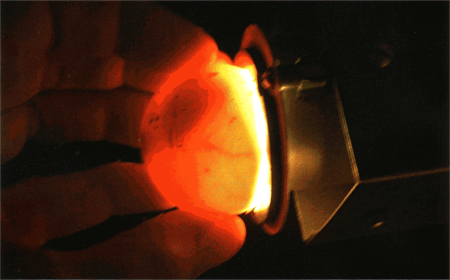Reproduction of the pig-nosed turtle Carettochelys insculpta
(RAMSAY, 1886) at the
Rotterdam Zoo. Radiata 14(3):3-12.
Gerard Visser & Henk Zwartepoorte
Comment: This was a great event for the Rotterdam Zoo and I need to acknowledge the authors and the Editor of Radiata (visit Radiata Website ) for permission to reproduce this paper here. This is one of the few times the species has been captive bred and the first time it has been fully detailed in the literature. Scott Thomson (2006).
Abstract
Rotterdam Zoo has had pig-nosed turtles in its animal collection since the large exhibition NOTOGAEA
(on Notogaean flora and fauna) in 1978, and added several specimens since. Over the years the animals
have been kept in two different enclosures, and in several combinations, due to size differences,
availability of space and aggressive behaviour. In 2004 three of the animals were kept together in a
15.000 1 aqua-terrarium, in the company of other large freshwater turtles and fishes. The animals were
separated again as one of them, later determined to be a male, had damaged one of the others, as
occurred in the years before on numerous occasions. In January 2005 one of the remaining turtles,
obviously a female, was found to have left the exhibit during the night, and to have produced three eggs
of which two were broken. She had done this in the public area of the building where the aqua-terrarium
is situated, the Rivikra-Hall. After the female had been placed in an off-exhibit enclosure, she produced
another 21 eggs after injection of Calcium-Sandozm and Oxytocine. Of these eggs, 15 successfully hatched,
after 84-1 12 days, and most after submersion in water. This is believed to be the fourth captive breeding
ever, and the first one that documents the complete reproduction process in captivity.
Introduction
The pig-nosed turtle Carettochelys insculpta is the only surviving member of its genus and the
family Carettochelyidae. It is found in northern Australia and southern New Guinea. The species is also
known as Fly River turtle, after the New Guinean river tributary where it was first collected. From this
single specimen, the species was described by Dr. E. P. RAMSAY in 1886. Epidermal scutes are absent. The
shell is covered with a continuous skin, similar to soft-shelled turtles. The limbs are paddle-shaped, as
in marine turtles, and each bears two claws. The fleshy proboscis, with the nostrils placed anteriorly,
gives the species its common name: pig-nosed (or pig-nose) turtle. Fully adult, they may grow to 55 to
60 cm (CANN 1978) and weigh more than 20 kg. Although primarily herbivores, animal matter is also taken.
DOODY et al. (2002) sexed the animals in north Australia by inspecting the tail length. In our case, with
animals of different sizes, this did not prove to be simple. Generally speaking, the tail of the males is
larger. The animals are largely aquatic, and are found in larger and smaller rivers, ponds, and lagoons,
with a soft sand or mud bottoms; sometimes also in brackish coastal waters. Carettochelys is now
included in the suborder Cryptodira, superfamily Trionychoidea (GEORGE'S & WOMBEY 1993). The IUCN has
classified the species as vulnerable (IUCN, 2004). CITES: Appendix 2.
|
The history of pig-nose turtles at Rotterdam Zoo |
|
As we were unsuccessful in getting our animals to breed, or in obtaining extra
specimens, we sent our presumed female out on breeding loan to a well-known German turtle breeder in 1988.
He had a male specimen, but as this project didn't result in successful matings either, the female was
returned to the Zoo in 1990. Later, two more sub-adult specimens (just very recently determined as males)
did become available on loan from a private person in 1995; a fully grown female, purchased, from a
private German keeper and one of (still) unknown sex, donated, 1998. One of the specimens acquired in 1978.
Contrary to our original assumption it turned out to probably be a male. It was loaned for breeding
purposes to Frankfurt Zoo (Germany) in 1999. In Rotterdam this resulted in a group of five specimens,
of which three are usually kept together in the 15,000 1 aquarium.
In 2004 the two females shared the large aqua-terrarium with one of the males that had arrived in
1995.


